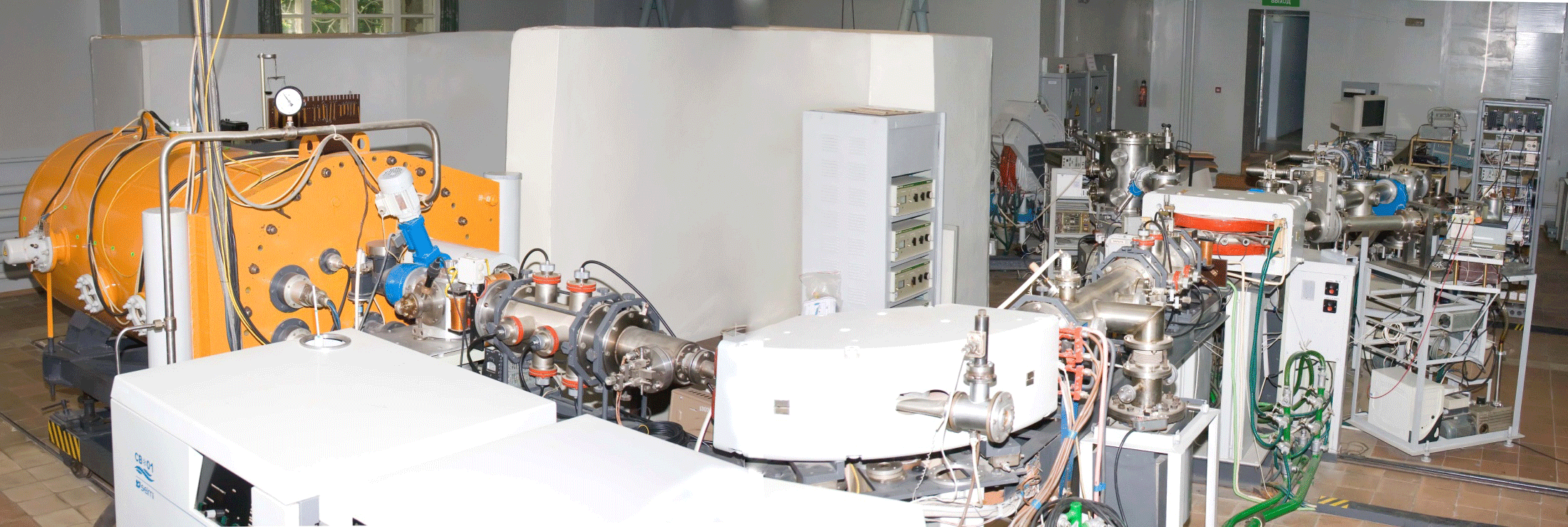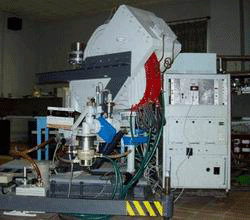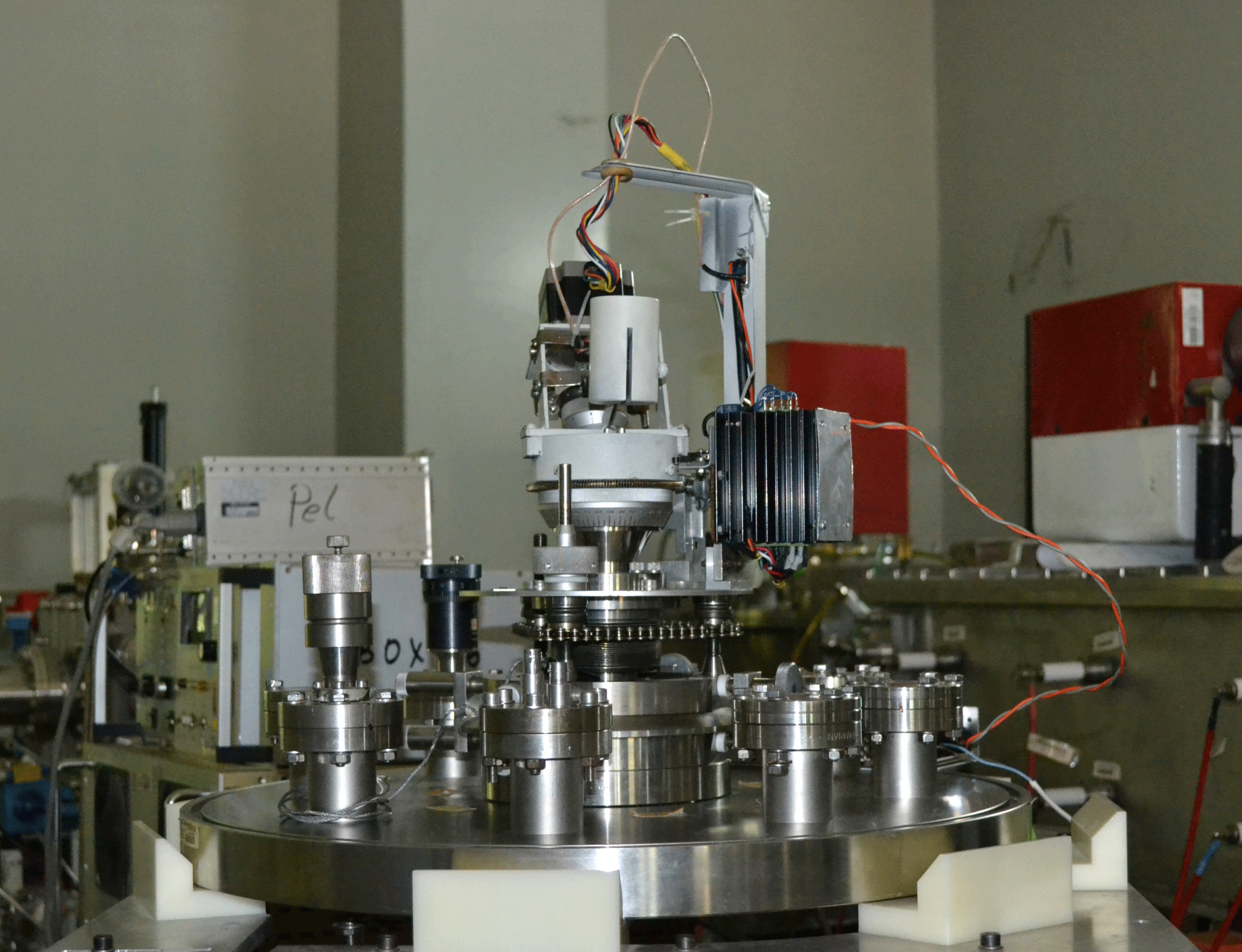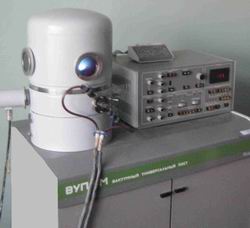Department of nuclear and physical research
Experimental facilities
- Analytical accelerator-based facility
An analytical facility constructed on a basis of a compact electrostatic IAP NASU accelerator allows studying structure and composition of various materials with the Rutherford back-scattering technique, recoil proton detection, resonant nuclear reactions, PIXE, ion lumuniscence.
An analytical facility constructed on a basis of a compact electrostatic IAP NASU accelerator allows studying structure and composition of various materials with the Rutherford back-scattering technique, recoil proton detection, resonant nuclear reactions, PIXE, ion lumuniscence. AAF specifications and methodological support are sufficient for applied and fundamental studies in various branches of science and engineering.
Analitical accelerating facility has:
- a compact EA of horizontal “Sokol” type;
- a beam transport system (BTS) with an analyzing magnet (AM), distributive magnet (DM), and ion guides;
- a scanning ion microprobe end-station (SIM);
- a Rutherford back-scattering end-station (RBS);
- a nuclear recoil end-station (NR);
- a nuclear reaction end-station (NR);
- an ion luminescence end-station (IL);
- accessory equipment (a gas supply system, an exhaust cart, a cooling system etc.)

General view of IAP NASU AAF
Universal experimental chambers, electrophysical apparatus and software on analytical end-stations AAF provide express research, with high resolution, and with basic and secondary nuclear and physical techniques.
Electrostatic Accelerator
AAF is constructed on a base of a compact EA of horizontal “Sokol” type. EA specifications:
| ion type |
Н+, Не+ |
| particle energy |
MeV 0.3-2.0 |
| energy homogeneity of a beam, % |
0.08 |
| proton beam current, µA |
up to 50 |
| operating mode |
nonstop |
| mass, t |
3.0 |
During construction and operation of AAF its construction was modified with some refinements. In particular, a high-frequency (HF) ion source was equipped with a system of constant magnets to densify plasma . To prevent emergencies at operation of an accelerator charge transporter, a system of a bend control of a high-voltage column was developed and assembled. A charging system of high-voltage conductor was upgraded to diminish instability of high voltage from a band. A system of X-ray suppression of a compact accelerator was also developed and constructed. Nd-Fe-B constant magnets installed along an accelerating tube decrease a radiation dose by two orders of magnitude.
Beam Transport System
A beam transport system of AAF has a beam monitoring chamber (1), electromagnetic correctors of a beam trajectory (2), two doublets of quadrupole electrostatic lenses (3), a magnet analyzer (4), inlet and outlet slit of a magnet analyzer (5, 6), inlet slit of a distribution magnet (7), a distribution magnet (8), vacuum suction system (9) with vacuum valve (10). At the outlet slit of a distribution magnet the beam transport system provides a proton current up to 5 μA with energy stability at least 0.08-0.1%. Beam size is within 5x5 mm. Vacuum in the system is provided by a vacuum suction system of a two-stage scheme. A fore-vacuum is created by LEYBOLD-HERAEUS D16A fore-vacuum pumps with a 7.5 l/sec. delivery. High vacuum is maintained with the EYBOLD-HERAEUS TURBOVAC 450 turbo-molecular pumps with 450 l/sec. delivery and an ion pump Nord-400. An evacuating system provides vacuum at least 10�4 ÷10�5 Pa within 20-30 min in ion guides.
Analytical End-Stations
IAP NASU AAF has five analytical end-stations: a scanning ion microprobe end-station (SIM), a Rutherford back-scattering end-station (RBS), a nuclear recoil end-station (NR), a nuclear reaction end-station (NR), and an ion luminescence end-station (IL). All the accessories on these end-stations were developed and constructed during past ten years by researchers and experts of IAP NAS of Ukraine. A distinctive feature of AAF is in three unique analytical end-stations meeting with world standards parameters. Specifications of these facilities are given below.
Scanning Ion Microprobe

General view of a scanning ion microprobe
SIM specifications:
| ion type |
Н+, Не+ |
| energy, MeV |
1.5 ÷ 1.8 |
| current on a target, pA |
10 ÷ 1000 |
| spatial distribution (at current on a target of 200 pA), micron |
1 ÷ 2 |
| analytical techniques |
PIXE, RBS, ERDA,SEE |
Rutherford Backscattering End-Station
The end-station is equipped with a magnet spectrometer registering energy of elastically scattered particles with a 3÷4 keV resolution. It allows studying the films with thickness from some nanometers to some microns.

General view of the RBS end-station
Determination: study of a structure and composition of film coatings of constructional materials. RBS specifications:
| ion type |
Н+, Не+ |
| energy, MeV |
1.5 ÷ 1.8 |
| current on a target, pA |
10 ÷ 1000 |
| energy resolution ΔE/E |
3.2×10-3 |
| analytical techniques |
RBS |
Elastic Recoil Detection Analysis Spectrometer
Determination: non-destructive qualitative analysis of hydrogen concentration in materials on the basis of nuclear recoil method. Apart from that the end-station may be applied for RBS technique both at reverse and sliding angles (for the RBS technique a Н+ accelerated beam is possible). Specifications of Nuclear Recoil End-Station:
| ion type |
Не+, Н+ |
| energy,MeV |
1.5 ÷ 1.8 |
| current on a target, nA |
10 ÷ 1000 |
|
energy resolution ΔE/E
(at beam energy of Не+ = 1500 keV), keV
|
1.5×10-3
1.5
|
| analytical technique |
ERDA, RBS |
| hydrogen limit of detection is |
1÷10 ppm |
Functionally, a nuclear recoil end-station consists of an ion guide, a scattering chamber, and an electrostatic spectrometer. The ion guide is equipped with a vacuum suction system providing a 10-6Pa vacuum, and a beam monitoring system. An interaction chamber is a Varian VT�118 chamber. It is equipped with a mechanism of target moving and a vacuum suction system providing a 10-7Pa vacuum, preventing organic contamination of the samples under study. Ultrahigh vacuum in the chamber is maintained by a seven stage ion vacuum pump in the chamber, a sublimation vacuum pump, and a “nitrogen trap”. A special mechanism moves the targets in the coordinates within a 10 microns accuracy and yaws them around a vertical axis by 360° within a 0.5° accuracy. The scattering chamber construction makes it possible to turn it around a vertical axis by angles from 0° to 135°. It allows experiments on both small-angle and back scattering. Accessory equipment is also possible to install (including detectors of charged particles, of characteristic X-rays, and of gamma-radiation). A special feature of the end-station is a precisious electrostatic spectrometer with energy resolution ΔE/E of 1.5×10-3. The spectrometer is equipped with a position sencitive detector, an automated control system of data acquisition. The equipment was supplied to IAP NAS of Ukraine by Max-Plank-Institute for Metals Research, Stuttgart, Germany.

General view of an electrostatic spectrometer in a nuclear recoil end-station.
The end-station is also applied for studying impurities and defects with a charged particles channeling technique. A lid with an automated goniometer is fixed onto the scattering chamber. The goniometer has five degrees of freedom (two rotation degrees and three translational degrees). Rotational degrees are automated with a stepping motor controlled by a computer. A step of the target moving is 0.01. It allows angle scanning in vicinity of crystal axes chosen. Translational degrees of freedom are used for a sample positioning and are manually controlled. A system of experiment automatization and data acquisition is based on a universal computer appliance (UPAK) developed at IAP NAS of Ukraine, consisting of a set of sensors, a module for registration and data transition, a network switch, a control module, and a device for visualization and data analysis, i.e. a personal computer and a special software, in general.

General view of a lid of a scattering chamber with an automated goniometer
Ion Luminescence End-Station
Determination: identification and characterization of non-organic materials; study of X-ray damages. Specification of the ion luminescence end-station:
| ion type |
Не+, Н+ |
| energy,MeV |
0.5 ÷ 1.8 |
| current on a target, nA |
10 ÷ 1000 |
| operational range of wave length |
200...800 nm |
| inverse linear dispersion |
3...4 nm/mm |
| analytical technique |
IBIL |

General view of an ion luminescence end-station
- Joint center: Accelerator mass spectrometer Tandetron 1.0 MV модель 4110Bo-AMS, produced by HVEE, Netherlands
Accelerator mass spectrometer Tandetron 1.0 MV Model 4110Bo-AMS is a facility of new generation that allows one to obtain precise information on isotope content of samples of milligramm amd submilligramm masses.
Methods of accelerator mass-spectrometry (AMS) allow one to carry out quantitative determination of both radioactive and metastable isotopes (for example, 14С, 10Be, 129I ) with high absolute (10-12 or ppt) and relative sensitivity (10-14 – 10-15). Extremely high resolution while counting isotopes with AMS is much greater than corresponding parameters of the mass-spectrometers with traditional ion separation.
The main research directions for Tandetron 1.0 MV Model 4110Bo-AMS to be used are the following:
- geophysical, biophysical and medicobiological studies
- archeology (object dating)
- radio-ecological studies (natural and technogenic samples from the Chernobyl Exclusion Zone and objects of the model experiments)
- materials science (structural materials for nuclear power and radiation technologies, semi-conductors and ultra-pure materials, biomaterials).
Technical parameters of the facility
| Sensitivity limits for typical isotope ratios (for example, 14С/12С) |
3•10-15 |
| Accuracy of measurements of the isotope ratios |
13С/12С – <0,3% 14С/12С – <0,5% (statistically while one-hour counting) |
| Other isotopes that can be quantitatively determined without modification of the facility |
3H, 10Be, 26Al; 129I (after little retuning of magnetic deflectors and register systems) |
| Number of samples in the sample holder |
50 |
| Time to change the samples |
1 min approx., selection of the samples for analysis is done randomly and is controlled by the software |
| Ion source |
cesium ions (Cs+) are produced by thermal ionization, then accelerated and bombarding the graphite target form carbon ions С-, which form the beam leaving the source . |
| Accelerating voltage of the Tandetron ion accelerator |
1000 кV |
The main advantages
Traditional methods allow one to measure radioisotope concentrations using their radioactive decay and to register β-particles emerging fom the sample. Accelerator mass-spectrometry permits direct counting of individual isotopes after their separation according to mass-to-charge ratio to be done. Sensitivity limits of isotope determination with Tandetron 1.0 MV Model 4110Bo-AMS are a few order of magnitude greater than while using secondary ion mass-spectrometry, neutron activation analysis and inductively coupled mass spectrometry.


Equipment of the joint center "Accelerator mass spectrometry",
IAP NAS of Ukraine
- Accelerator mass spectrometer Tandetron Model 4130-AMS модель 4110Bo-AMS HVEE B.V. HVEE Europa B.V. (Netherlands).
- «DILO» facility ( Germany ) to storage, purification, drying.
According to the programme of a centralized buying of the foreign scientific instrumnets and equipment of NAS of Ukraine, the Institute of Applied Physics NAS of Ukraine carried out a preparation and put into operation the accelerator mass-spectrometer Tandetron 1.0 MV Model 4110Bo-AMS HVEE B.V.
Start-up and commissioning of the 4110 Во-AMS included the following: testing and verification of parameters of all AMS units, trial measurements of Carbon isotope ratios using standard samples, adjustment and optimization of the ion-optical system, which allow metrological characteristics to be obtained.

Scheme of the accelerator mass spectrometer Tandetron 1.0 MV model 4110Bo-AMS HVEE B.V.
Facility parameters ( pasport and obtained )
| Ratios |
Sensitivity ( in the brackets - experimentally obtained ) |
Error ( in the brackets - experimentally obtained ) |
| 14C/12C |
3х10-15 (2.3х10-15 ) |
≤ 0.5 % (0.384 % ) |
Диск для фіксації твердофазових зразків з наступним аналізом на вмі ст 14С прискорювальним мас-спектрометром Tandetron 1.0 MV модель 4110Bo-AMS HVEE B.V.
The facility can determine not only light isotopes such as 10Be, 14C and 26Al, but also heavy elements such as 129I. Measurements of isotope ratios 14C/12C, 10Be/9Be, 26Al/27Al, and 129I/127I obtained using accelerator mass-spectrometer 4110Bo-AMS are given in the Table : Carbon 14C/12C 13C/12C
| Element |
Isotope ratio |
Background for isotope ratio |
Accuracy |
| Carbon |
| Graphite |
14C/12C |
3х10-15 |
(1х10-15) |
≤0.5% (0.3%) при ~10-12 |
| Gas CO2 |
13C/12C |
1х10-14 |
(3х10-14) |
≤0,3% (0,2%) при ~10-12 |
| 14C/12C |
≤0,5% (0,3%) при ~10-12 |
| 13C/12C |
≤0,3% (0,2%) при ~10-12 |
| Berillium |
10Be/9Be |
3х10-14 |
(3х10-15) |
≤3% (1%) при ~10-12 |
| Aluminium |
26Al/27Al |
5х10-14 |
(1х10-15)* |
≤3% (1.0%) при ~10-11 |
| Iodine |
129I/127I |
|
(1х10-12) |
(5%) при ~10-10 |
- Vacuum station ВУП-5М
Magnetron atomization of materials

Vacuum station ВУП-5М
ВУП-5М station has devices for magnetron atomization of materials and ion sputtering.
|
On December 22, 2021, the National Academy of Sciences of Ukraine announced a competition to replace the director of the Institute of Applied Physics of the National Academy of Sciences of Ukraine.
According to the Statute of the NAS of Ukraine, the right to nominate candidates for the position of director of a scientific institution has: the Presidium of the NAS of Ukraine, the Bureau of the relevant branch of the NAS of Ukraine, members of the NAS of Ukraine, the Academic Council of the institution.
A candidate for the position of director of a state scientific institution must be fluent in the state language, have a doctorate or doctor of philosophy and work experience as a researcher and (or) research and teaching staff of at least 10 years.
Training of scientific personnel
|









